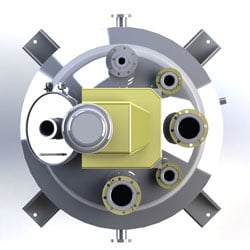Designing a Glass-Lined Vessel: A Practical Overview on Specifying a Reactor [Part 2]
 Editor’s Note: This post was originally published in January 2015 and has been updated for accuracy, clarity, and to reflect the latest information.
Editor’s Note: This post was originally published in January 2015 and has been updated for accuracy, clarity, and to reflect the latest information.
In last week’s blog post, we started walking through the key details in our Glass-Lined Reactor Specification Form to help you understand the information we need to prepare an accurate quote for your vessel. In this second installment of our three-part series, we’ll continue down the form, focusing on working conditions, environmental factors, and exterior design considerations.
Working Conditions
To ensure your vessel is engineered for safe, reliable performance, we need a clear picture of the conditions it will face in operation. This includes both process parameters and jacket or coil requirements:
- Inner Vessel Pressure and Temperature – The expected operating and design requirements for the process side of the reactor.
- Jacket Pressure and Temperature – For reactors with conventional jackets, specify the operating and design parameters.
- Half-Coil Pressure and Temperature – For HemiCoil® designs, provide the same data as above.
If you’re using a conventional jacket or HemiCoil, also list the intended heating/cooling media. This helps us determine if special zoning or circuit arrangements will be needed for optimal heat transfer and safety.
Areas and Zones
The environment where your reactor will be installed plays a big role in its design. Let us know if your site falls under any special hazard classifications, such as:
- Explosion-proof areas with flammable gases, vapors, or dust.
- Seismic zones where structural reinforcement is required.
- Specific gas groups and temperature classes that apply to your process.
For example, if your unit is installed in an area with combustible dust hazards, an upgrade to an XP (explosion-proof) model with intrinsic safety features may be required. Providing this information upfront ensures your vessel is engineered for compliance and long-term safety.
Exterior Design
While the inside of your reactor is where the chemistry happens, the exterior finish and components are just as important for durability and performance.
De Dietrich standard exterior finish:
- Primer: Sherwin Williams Zinc Clad® IV Organic Zinc-Rich Epoxy (Gray)
- Finish: Sherwin Williams Acrolon® 218 HS Acrylic Polyurethane (Gray)
If you prefer a different finish or color, simply provide the material of construction and the RAL color number.
Nozzles and Manway Covers
De Dietrich’s model reactors come equipped with a standard set of nozzles on the top head. Before fabrication, additional nozzles can be incorporated into the design to better support specific process objectives.
The manway cover is available in several arrangements. The standard design features a dished cover with one sight glass. Alternatives include a flat cover with one fused sight glass and one quick easy-opening, or a flat cover with two fused sight glasses. To protect the glass lining, opening assistance can be added through a davit or spring assist, helping to prevent accidental drops or forceful closures.
For enhanced visibility, a halogen or fiber-optic lighting fixture can be installed onto the sight glass, allowing operators to perform visual inspections of the reactor’s contents. At the bottom of the vessel, the outlet nozzle is available in the standard design or with a pad flange.
HemiCoil® Jacket Arrangement
Choosing a HemiCoil® jacket offers flexibility in creating multiple heating/cooling zones to improve heat transfer efficiency and prevent cross-contamination of media. Available arrangements include:
- 1 circuit / 1 zone
- 1 circuit / 2 zones
- 1 circuit / 3 zones
- 2 independent circuits
Read more about jacket selection here.
Insulation
We can insulate the shell and bottom head in stainless steel, foam glass, mineral wool, or other materials, depending on your temperature and process needs.
Key considerations:
- Insulation thickness is ultimately a result of heat transfer requirements.
- Inspection ports can be added for maintenance access.
- Insulation rings are recommended to keep the sheathing secure.
If you’re unsure which insulation material is best, our team can help guide the selection.
Support
The right vessel support system depends on your reactor’s size and installation site. Options include:
- Support legs
- Lugs
- Support rings
- Skirts
We’ll work with you to determine the most stable support for your equipment.
In our final post of this series, we’ll explore mixing systems and peripheral equipment options that complete your reactor setup. In the meantime, you can download our full Glass-Lined Reactor Specification Form to start the process and get one step closer to a custom-built vessel that meets your exact needs.
